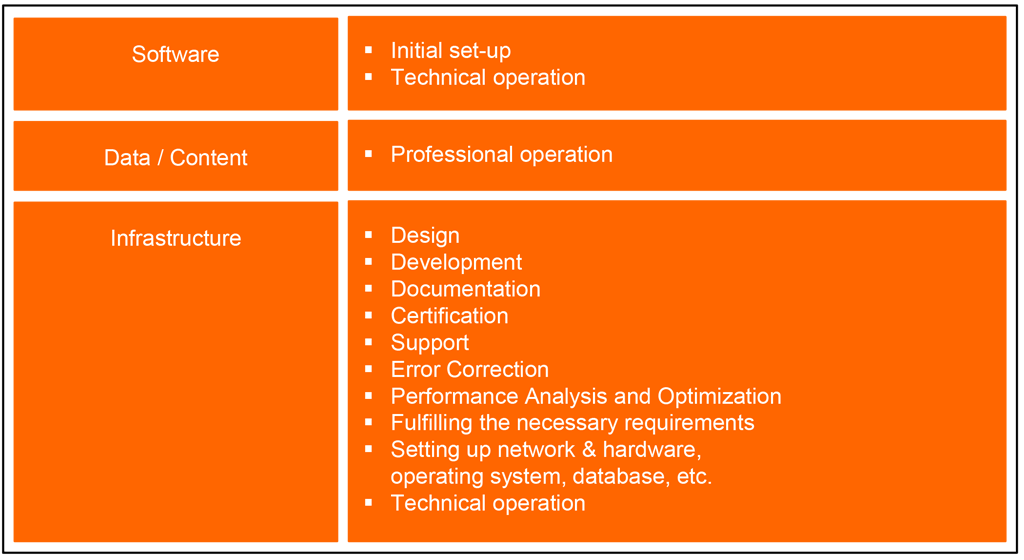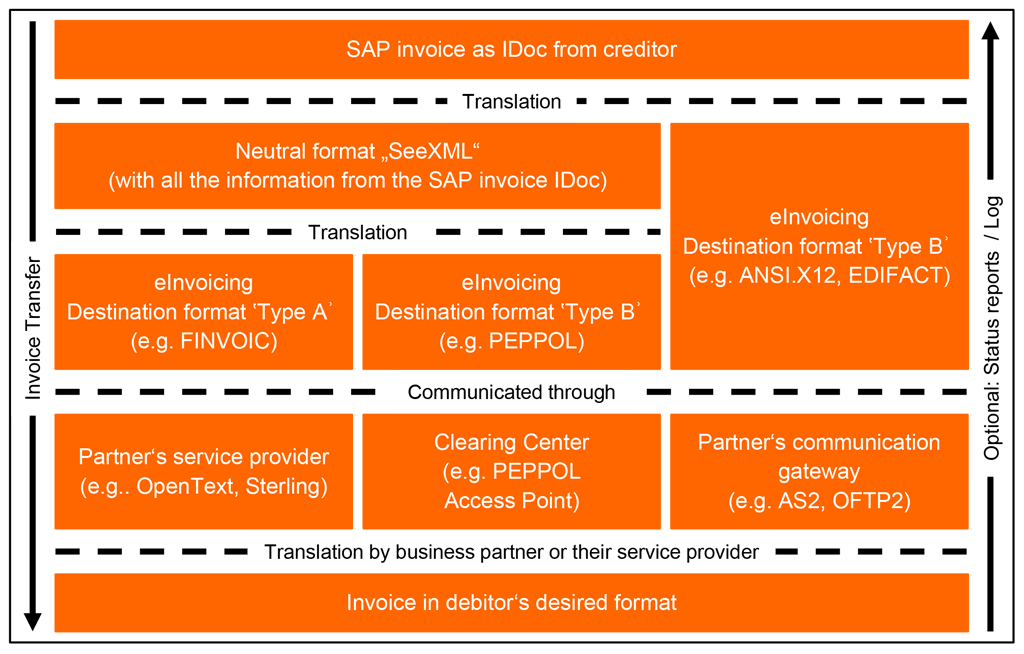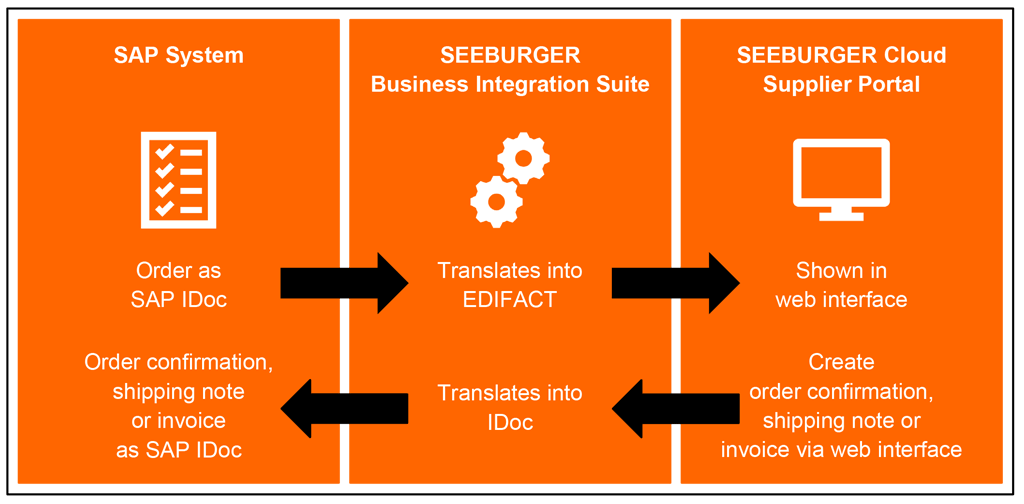Lots to do, too few Resources? Operating Options for eInvoicing and WebEDI

Many IT departments have to struggle with a permanently high workload, and can not fulfill requests from the business departments as quickly as everybody would like.
Sometimes, these are requests which would benefit the company, or are even legally necessary. This annoys everybody involved.
A “Cloud First” approach, which many companies already take, can help here.
Call in a third party
Among the requests sent to a Business Integration Team are often topics which need to follow clear specifications and do not allow any room for interpretation.
Examples of specifications could be:

The clearer such specifications are, the more they lend themselves to the support of a third party who have experience in implementing these matters. This can happen in several different ways.
Use standardized software
Standardized or off-the-shelf software is easy and efficient to use. Here are some of the tasks that the manufacturer is responsible for, significantly reducing your own workload.

A partner like SEEBURGER can provide you with its Business Integration Suite – a full integration platform that can grow to fit your needs – as standardized, off-the-shelf software.
This can be implemented with just a short lead time. Adjustments to the software for your specific needs can usually be done by configuring the software.
Any adjustments due to technology changes, such as a new operating system, a new database version or new integration technology e.g. OFTP2 to replace OFTP1, are done by the manufacturer. Updates are provided automatically with new service packs.
Functional extensions, such as for AS2 communication or PGP encryption can be added quickly and easily and used with the platform’s existing tools, such as monitoring or configuration.
Using components all supplied by one manufacturer, or offered as an extension to their software, ensures compatibility when for example using a component, or if you need to access error or monitoring information.
Use standardized services
Software as a Service (SaaS) even goes one step further than standardized software. In this scenario, the manufacturer or service provider further reduces your workload by also taking on the following tasks:

Operation options for eInvoicing
A good example of standardized services in the area of business integration is eInvoicing.
For eInvoicing, various industry-specific or country-specific procedures and conditions need to be considered, which lead to an almost infinite number of possible variations.
The following diagram shows the complexity of various eInvoicing processes:

When considering your eInvoicing needs, it is worth evaluating what can be done by yourself and what could potentially be done more efficiently by partners like SEEBURGER.
Here it is helpful to have an option, designed on a modular basis, so you only take what you need.
For eInvoicing, you need to find solutions for the following components:
- Translation (starting with e.g. an SAP invoice IDoc) into a neutral format and into a specific target format
- Low effort option:
Provided by SEEBURGER + operated within the SEEBURGER Cloud - Medium effort option:
Standard mappings provided by SEEBURGER + operated on own BIS system - High effort option:
Develop own maps + operate on own BIS system
- Low effort option:
- Communication with business partner
- Low effort option:
Operated by SEEBURGER - Medium effort option:
Operated on own BIS system using standard communication technologies such as AS2 or OFTP2 - High effort option:
Operated on own BIS system using specialized communication technologies such as additional service providers or clearing centers
- Low effort option:
If you decide to involve a business partner for specific components, you can benefit from a reduced workload as well as from their expertise and the service level agreements (SLA) agreed with the partner.
Options for operating WebEDI to integrate suppliers
Another example of a standardized service is WebEDI.
This service provides suppliers without EDI capabilities a web interface (such as the SEEBURGER Supplier Portal in the SEEBURGER Cloud) to view and download orders in various formats (such as PDF and CSV). The supplier receives an e-mail when a new order is placed.
The supplier uses the web interface to quickly and easily create related documents such as an order confirmation, shipping note or invoice. This service is not only quick, but also minimises errors as the information is drawn from the order itself. Essentially, the order is turned into an order confirmation or shipping note by adding information such as a supplier reference number and a delivery date.
WebEDI can be used by the customer in a fully automated way, by using documents that are already used in EDI. You can also specify mandatory information which the supplier needs to provide. This ensures you receive high quality data and enables a high degree of automation.

Just as with eInvoicing, various options can be selected to provide the WebEDI service you actually need.
Conclusion
A centralized Business Integration Team should always consider involving third parties when faced with new requirements. They complement their own team and should be seen as an opportunity rather than competition.
Based on the wide range of tasks a Business Integration Team is expected to deal with, it is worth considering how at least a part of the workload could be transferred to an external partner by using standardized software or standardized services. That would allow the Business Integration Team to better focus on requests coming from within the company.
Thank you for your message
We appreciate your interest in SEEBURGER
Get in contact with us:
Please enter details about your project in the message section so we can direct your inquiry to the right consultant.
Written by: Oliver Rupprecht
Oliver Rupprecht works for OSRAM since 1995 and deals with Business Integration and the digital change since 2001. He is responsible for the global integration platform at ams OSRAM and supports on consulting, conception and realization of integration demands.





